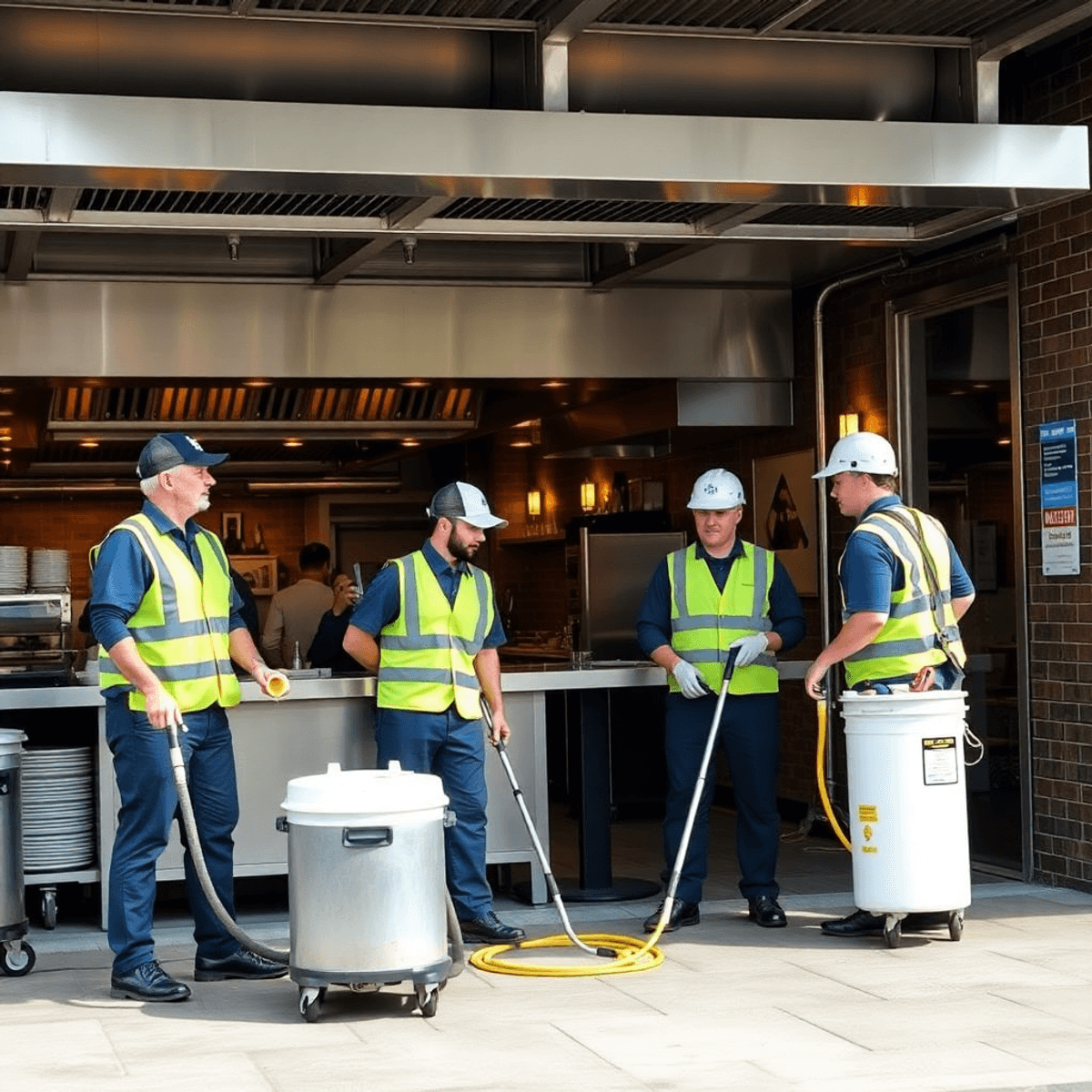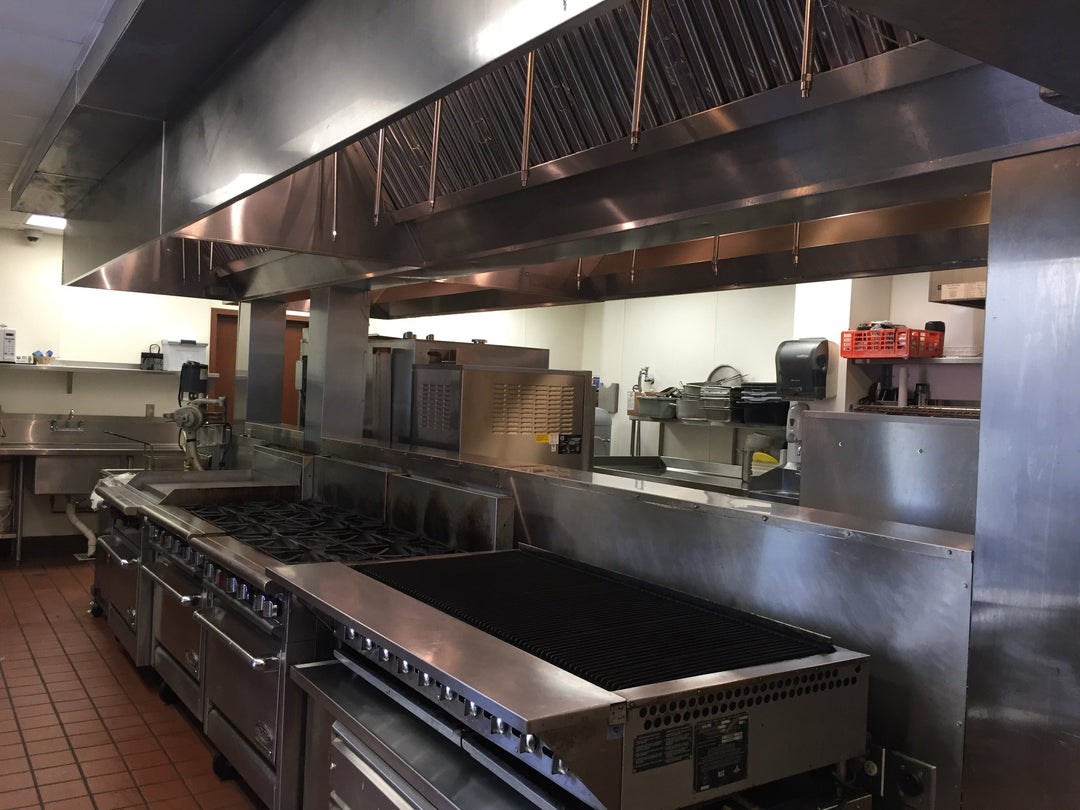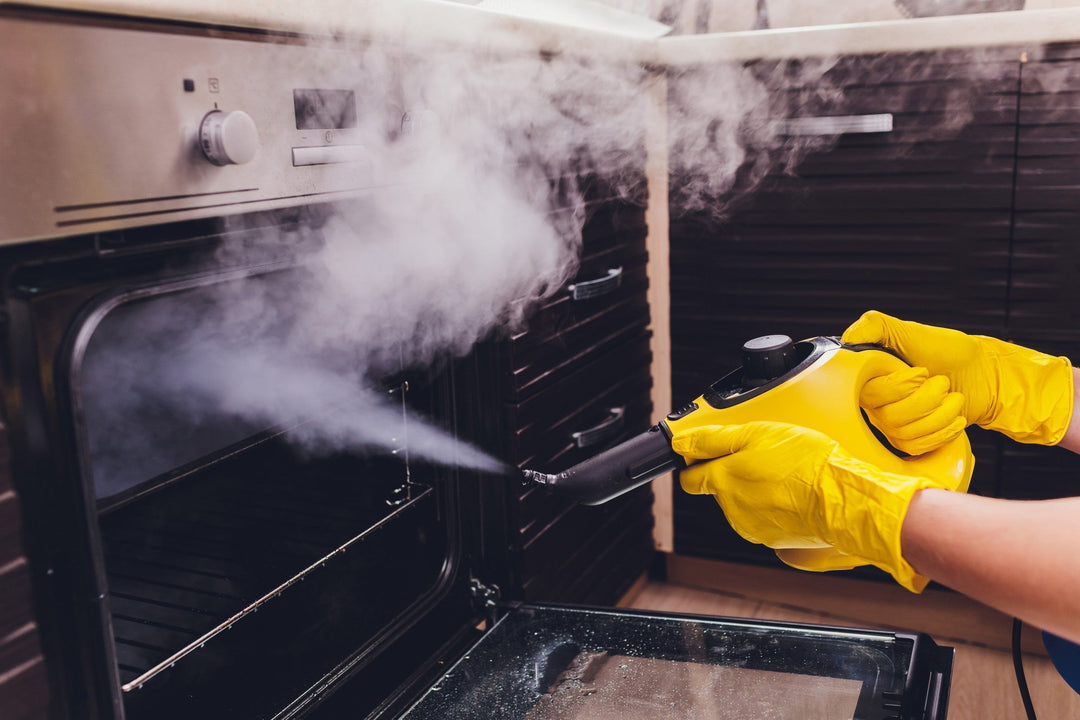How to Expand Your Solo Exhaust Cleaning Service into a Full Team

The kitchen exhaust cleaning industry presents significant growth opportunities for ambitious entrepreneurs. With strict fire safety regulations mandating regular cleaning of commercial kitchen exhaust systems, the demand for professional cleaning services remains consistently high.
Starting as a solo cleaner provides valuable hands-on experience and industry knowledge. A single technician can service 2-3 commercial kitchens per day, generating steady revenue. The real potential lies in scaling operations to handle multiple clients simultaneously.
Key Growth Indicators in the Exhaust Cleaning Market:
-
Rising number of restaurants and commercial kitchens
-
Stricter safety regulations across states
-
Increased awareness of fire prevention
-
Growing demand for specialized cleaning services
Scaling from a solo operation to a full team unlocks substantial benefits:
-
Increased Revenue: Multiple teams can service more clients daily
-
Market Expansion: Coverage of larger geographic areas
-
Service Diversification: Ability to handle different types of cleaning jobs
-
Enhanced Client Relationships: Dedicated staff for sales and customer service
-
Operational Efficiency: Specialized roles for better service delivery
The transition from solo cleaner to team leader requires strategic planning, investment in equipment, and development of systematic processes. This guide provides actionable steps to scale your exhaust cleaning business while maintaining service quality and regulatory compliance.
One way to enhance your service offering is by investing in specialized equipment such as the MFS Electrostatic Misting Fogger, which can significantly improve the efficiency of your cleaning process. Additionally, understanding cooking oil filtration can provide added value to restaurant clients by helping them maintain their kitchen equipment better.
Furthermore, incorporating tools like the 100 Pressure Washing Hose into your arsenal can diversify your service offerings. It's also crucial to stay updated with essential seasonal maintenance tips for kitchen exhaust systems to ensure optimal performance of the systems you clean.
Lastly, consider starting with a comprehensive package such as the Silver Package Exhaust Hood Cleaning, which covers all necessities for a successful start-up in this lucrative industry.
Understanding the Exhaust Cleaning Industry
Kitchen exhaust hood cleaning is a crucial specialized service within the commercial cleaning industry. The demand for professional exhaust cleaning services continues to grow as restaurants, hotels, and institutional kitchens recognize the importance of maintaining clean and safe kitchen ventilation systems.
Market Demand Drivers:
-
Fire prevention requirements from insurance companies
-
Health department compliance mandates
-
Growing awareness of indoor air quality
-
Rising number of commercial food establishments
Safety and Environmental Regulations
The exhaust cleaning industry operates under strict regulatory frameworks designed to protect public safety and environmental health:
NFPA 96 Standards
-
Minimum cleaning frequency requirements
-
Acceptable cleaning methods and materials
-
Documentation and reporting protocols
Environmental Protection Guidelines
-
Proper disposal of cleaning chemicals
-
Grease and waste management procedures
-
Water runoff control measures
Regional Certification Requirements
Professional exhaust cleaners must obtain specific certifications based on their operating location:
Required Certifications:
-
NFPA training completion
-
Local health department permits
-
State-specific contractor licenses
Additional Qualifications:
-
Hood cleaning safety certification
-
Hazardous materials handling training
-
Equipment operation certifications
-
Insurance carrier requirements
The specialized nature of kitchen exhaust cleaning requires a thorough understanding of ventilation systems, cleaning techniques, and safety protocols. Successful operators must keep their certifications up to date while staying informed about changing industry standards and new developments in cleaning equipment and methods.
To navigate this complex landscape, it's essential for professionals in the field to be well-versed in various aspects of building services and systems. This knowledge is crucial for ensuring compliance with safety regulations such as those outlined in the NFPA 96 standards.
Importance of Kitchen Exhaust Cleaning
Regular kitchen exhaust cleaning not only improves health ratings but also ensures compliance with health department standards. This is crucial for maintaining a safe cooking environment.
Furthermore, effective hood cleaning strategies can significantly reduce fire hazards in kitchens. You can read a detailed case study on effective kitchen hood cleaning strategies that prevent fire hazards, which highlights the importance of this specialized service in ensuring safety in commercial kitchens.
For those interested in entering this rewarding field, understanding the costs, training, and certification requirements is essential. These factors play a significant role in establishing a successful hood cleaning business.
Crafting a Solid Business Plan for Growth
A structured business plan serves as your roadmap for transforming your solo exhaust cleaning operation into a thriving team-based enterprise. Your plan needs to address specific growth elements:
Revenue Projections and Financial Goals
-
Monthly revenue targets based on market analysis
-
Profit margins for different service categories
-
Capital requirements for equipment and hiring
-
Cash flow forecasts for the first 12-24 months
Market Analysis and Client Targeting
-
Commercial kitchens in high-density areas
-
Restaurant chains seeking multi-location contracts
-
Healthcare facilities with strict cleaning requirements
-
Educational institutions with large-scale operations
Competitive Pricing Strategy
-
Base rates for standard exhaust cleaning services
-
Premium pricing for specialized cleaning requirements
-
Volume discounts for multi-location contracts
-
Emergency service surcharges
Your pricing model should reflect both market rates and operational costs:
Standard Service Rate = Base Cost + Labor + Equipment + Overhead + Profit Margin
Key Business Plan Components
-
Detailed market analysis
-
Competitor assessment
-
Marketing strategy
-
Operational procedures
-
Financial projections
-
Risk management protocols
-
Growth timeline
A well-structured business plan helps secure financing from lenders and demonstrates professionalism to potential corporate clients. Regular plan reviews and updates ensure your growth strategy remains aligned with market conditions and business objectives.
Your expansion goals should be SMART (Specific, Measurable, Achievable, Relevant, Time-bound):
-
Increase monthly revenue by 25% within 6 months
-
Add two certified technicians per quarter
-
Achieve an 85% client retention rate
-
Secure three new corporate contracts monthly
To achieve these ambitious goals, consider leveraging the power of mentorship. As discussed in this article about how mentorship can accelerate your cleaning business growth, seasoned industry experts can provide valuable insights that help navigate challenges and seize opportunities.
Furthermore, incorporating custom video reviews into your marketing strategy can significantly enhance customer trust and engagement. These personalized video testimonials offer potential clients real experiences and insights from satisfied customers, making your service offerings more relatable.
Lastly, don't forget about the importance of maintaining cleanliness in your operations. Utilizing high-quality products like the freezer cleaner can ensure that your equipment is always in top condition, further contributing to the success of your business.
With these strategies in place, you will be well on your way to successfully transforming your hood cleaning business, as illustrated in this guide on transforming a hood cleaning business in just one year.
Legal Compliance and Licensing Essentials
Scaling your exhaust cleaning business requires strict adherence to regulatory requirements and licensing standards. The commercial kitchen cleaning industry operates under specific legal frameworks designed to protect public safety and environmental standards.
Required Licenses and Permits:
-
Business Operation License
-
Environmental Compliance Permit
-
Commercial Kitchen Cleaning Certification
-
Hazardous Materials Handling License
-
Local Health Department Approval
Regulatory Compliance Standards:
-
NFPA 96 Guidelines
-
OSHA Safety Requirements
-
State-specific Environmental Regulations
-
Local Fire Department Codes
-
Insurance Coverage Requirements
Your business must maintain detailed documentation of compliance activities:
-
Regular safety inspection records
-
Employee certification updates
-
Equipment maintenance logs
-
Chemical handling procedures
-
Waste disposal documentation
Regional Variations in Requirements
Different jurisdictions enforce varying standards for exhaust cleaning operations. Contact your local authorities:
-
City Business Development Office
-
State Environmental Protection Agency
-
Regional Fire Marshal
-
Health Department
-
Building Code Enforcement Office
Insurance Requirements
Professional liability coverage must scale with your team size:
-
General Liability Insurance
-
Workers' Compensation
-
Vehicle Insurance for Service Fleet
-
Property Damage Coverage
-
Professional Indemnity Insurance
Working with a legal professional specializing in commercial cleaning services helps navigate complex regulatory requirements. Regular audits ensure continued compliance as your business grows. Proper documentation systems track renewal dates for licenses, certifications, and insurance policies.
Building Your Team: Hiring and Training Strategies
Successful team expansion requires strategic hiring practices and robust training programs. A well-structured recruitment process helps identify candidates who possess both technical aptitude and alignment with your company values.
Essential Qualities to Look for in Candidates:
-
Strong work ethic and reliability
-
Physical stamina for demanding cleaning tasks
-
Problem-solving abilities
-
Safety-conscious mindset
-
Customer service orientation
-
Team player attitude
Recruitment Channels:
-
Industry-specific job boards
-
Local vocational schools like MFS Trade School, which are bridging America's skills gap
-
Professional networking events
-
Employee referral programs
-
Social media platforms
Creating comprehensive training programs ensures consistent service quality across your team. Your training curriculum should cover:
Technical Skills Development:
-
Proper use of cleaning equipment
-
Chemical handling procedures
-
Ventilation system inspection techniques
-
Documentation and reporting practices
Safety Training Components:
-
Personal protective equipment (PPE) usage
-
Emergency response procedures
-
Fire safety protocols
-
Height safety measures
-
Understanding of NFPA 1582 guidelines for physical fitness in firefighting roles, which can be adapted for our team's safety training
Customer Service Excellence:
-
Professional communication standards
-
Site preparation and cleanup
-
Client property protection
-
Service documentation
-
Complaint handling procedures
Implement a structured onboarding process:
-
Initial classroom training (1-2 weeks)
-
Hands-on equipment practice with certification programs to enhance team credentials and service credibility
-
Shadowing experienced team members
-
Supervised solo work
-
Regular performance evaluations
Track training progress through:
-
Skills assessment checklists
-
Video documentation
-
Written tests
-
Practical demonstrations
-
Client feedback reports
Regular refresher courses keep your team updated on:
-
New cleaning technologies
-
Updated safety regulations
-
Equipment modifications
-
Industry best practices
Maintain detailed training records for compliance purposes and career development tracking.
Investing in Equipment for Operational Efficiency
Strategic equipment investment drives business growth and service excellence in exhaust cleaning operations. A systematic approach to equipment acquisition ensures optimal resource allocation and enhanced service delivery capabilities.
Essential Equipment Assessment
-
Conduct a thorough inventory analysis of current cleaning tools
-
Document equipment utilization rates and maintenance records
-
Project future capacity requirements based on growth targets
-
Calculate the potential return on investment for new equipment
Advanced Tools for Enhanced Operations
-
High-powered vacuum systems with multiple intake ports
-
Automated scraping tools with adjustable pressure settings
-
Advanced inspection cameras for detailed documentation
-
Portable pressure washing units with heating capabilities
-
Smart scheduling software for equipment tracking
Equipment Investment Strategies
-
Start with core equipment upgrades that directly impact service quality
-
Implement a phased acquisition plan aligned with business growth
-
Consider equipment financing options to preserve working capital
-
Establish preventive maintenance schedules for all equipment. Regular maintenance is crucial as it boosts efficiency, reduces downtime, and saves on costly repairs. Learn more about why regular equipment maintenance matters.
-
Track equipment performance metrics to justify future investments
Technology Integration
-
Digital monitoring systems for equipment performance
-
Cloud-based maintenance tracking platforms
-
Mobile apps for real-time equipment status updates
-
GPS tracking for mobile equipment units
-
Automated cleaning verification systems
Equipment investment decisions should align with your service expansion goals. Regular equipment audits help identify gaps in operational capabilities and opportunities for efficiency improvements. Modern cleaning technologies can significantly reduce service time while maintaining high-quality standards.
Marketing and Branding to Attract More Clients
A distinctive brand identity sets successful exhaust cleaning companies apart from competitors. Your brand should reflect professionalism, reliability, and expertise in commercial kitchen exhaust cleaning.
Essential Brand Elements:
-
Professional logo incorporating industry-relevant symbols
-
Consistent color scheme across all materials
-
Clear brand messaging emphasizing safety and compliance
-
High-quality uniforms and vehicle wraps with company branding
Digital Marketing Strategies
-
Website optimization for local searches
-
Regular blog posts about kitchen safety and compliance
-
Video content showing cleaning processes
-
Google Business Profile optimization
Social Media Presence
-
LinkedIn for B2B connections
-
Instagram for visual documentation
-
Facebook for community engagement
-
Regular posts showcasing completed projects
-
Client testimonials and success stories
Referral Program Structure
-
Incentives for existing clients
-
Partnership with restaurant equipment suppliers
-
Network with fire safety inspectors
-
Collaboration with commercial property managers
Content Marketing Focus
-
Educational materials about fire safety, including training courses such as the Online Kitchen Exhaust Hood Cleaning course offered by MFS Trade School.
-
Industry compliance updates
-
Kitchen maintenance tips
-
Cost-saving benefits of regular cleaning
Local Marketing Tactics
-
Chamber of Commerce membership
-
Restaurant association participation
-
Trade show presentations
-
Local business networking events
Implement tracking systems to measure marketing ROI across channels. Monitor key metrics like website traffic, lead generation, and conversion rates. Adjust strategies based on performance data to optimize client acquisition efforts.
Direct mail campaigns targeting specific commercial zones can complement digital marketing efforts. Create professional brochures highlighting your team's expertise, certifications, and commitment to safety standards.
Streamlining Operations Management for Scalability
Efficient operations management is crucial for expanding your exhaust cleaning business successfully. By strategically using digital tools, you can replace slow manual tasks with smooth workflows.
Digital Scheduling Systems
-
Cloud-based scheduling platforms enable real-time team coordination
-
GPS tracking features optimize route planning for multiple crews
-
Automated appointment reminders reduce no-shows
-
Digital job calendars prevent double-booking incidents
-
Mobile apps allow field teams to access schedules instantly
Automated Payment Solutions
-
Digital invoicing software generates professional bills in seconds
-
Payment integration systems enable instant credit card processing
-
Automated payment reminders help maintain steady cash flow
-
Cloud storage preserves financial records securely
-
QuickBooks integration simplifies accounting procedures
Operational Efficiency Tools
-
Digital checklists standardize service quality across teams
-
Time-tracking systems monitor job duration accurately
-
Inventory management software prevents equipment shortages
-
Job completion reports document service delivery
-
Customer feedback collection through automated surveys
The right combination of scheduling systems and invoicing software creates a scalable operational framework. Digital solutions reduce manual data entry by 75% and cut administrative hours by half. These operational efficiencies allow business owners to focus on strategic growth initiatives while maintaining service excellence.
A strong digital setup supports multiple teams working at the same time in different places. With real-time access to data, you can make quick decisions and allocate resources effectively—two key factors in managing a growing exhaust cleaning business.
Financial Management for Sustainable Growth
Scaling your exhaust cleaning business demands robust financial management practices. A structured approach to cash flow monitoring and payroll administration creates a stable foundation for sustainable growth.
Cash Flow Management Essentials
-
Track accounts receivable aging to identify late-paying clients
-
Maintain detailed records of equipment maintenance costs
-
Monitor monthly revenue trends against operational expenses
-
Set aside emergency funds for unexpected equipment repairs
-
Create cash flow projections for seasonal business fluctuations
Strategic Financial Planning
-
Establish clear payment terms with new commercial clients
-
Implement deposit requirements for large cleaning projects
-
Build relationships with financial institutions for potential credit lines
-
Review pricing structures quarterly to maintain profit margins
-
Track key performance indicators (KPIs) through financial dashboards
Efficient Payroll Systems
-
Select user-friendly payroll software compatible with your accounting system
-
Set up direct deposit options for employee convenience
-
Integrate time-tracking tools with payroll processing
-
Automate tax calculations and deductions
-
Maintain accurate records of overtime and holiday pay
Cost Control Measures
-
Analyze equipment utilization rates to optimize resource allocation
-
Monitor cleaning supply inventory levels
-
Track fuel consumption across service vehicles
-
Review insurance costs and coverage annually
-
Implement purchase approval processes for major expenses
Proper financial management requires dedicated attention to both income and expenses. Regular financial health assessments help identify potential issues before they impact business operations. Professional accounting support can provide valuable insights for strategic decision-making during expansion phases.
Prioritizing Safety, Insurance Coverage, and Customer Service During Expansion
Safety protocols are crucial for a growing exhaust cleaning operation. Here are some essential workplace safety measures you should implement:
Daily Equipment Inspections
-
Pre-job safety checklists
-
Regular maintenance schedules
-
Documentation of equipment conditions
Personal Protective Equipment (PPE)
-
Respiratory protection
-
Non-slip footwear
-
Heat-resistant gloves
-
Safety harnesses for elevated work
Emergency Response Plans
-
First aid protocols
-
Fire safety procedures
-
Chemical spill containment
Insurance coverage must scale alongside your business growth. Secure these critical policies:
-
General liability insurance: $1-2 million minimum coverage
-
Workers' compensation insurance
-
Commercial vehicle insurance
-
Professional liability coverage
-
Property damage protection
Client communication becomes increasingly vital as your team expands. Establish these service quality measures:
Pre-Service Communication
-
Detailed scope of work
-
Timeline expectations
-
Safety precautions, including our advanced virus disinfection methods for commercial kitchens
-
Property protection methods
During Service Updates
-
Progress reports
-
Photo documentation
-
Issue notifications
-
Schedule adjustments
Post-Service Follow-up
-
Service completion reports
-
Quality assurance checks
-
Client feedback collection
-
Maintenance recommendations
Trust-building practices strengthen client relationships during expansion:
-
Standardized service protocols
-
Consistent pricing structures
-
Transparent communication channels
-
Regular staff training updates on essential restaurant cleanliness tips
-
Quality control measures
-
Response time standards
Document all safety incidents, insurance claims, and client interactions through digital management systems. This data-driven approach enables continuous improvement of safety protocols and service delivery standards while maintaining compliance with industry regulations.
Continuous Improvement for Long-Term Success in the Exhaust Cleaning Industry
Success in the exhaust cleaning industry requires constant adaptation to new industry best practices and technological advancements. A proactive approach to professional development sets industry leaders apart from competitors.
Key Areas for Continuous Improvement:
1. Technical Knowledge Updates
-
Subscribe to industry publications
-
Attend professional conferences
-
Join trade associations
-
Participate in certification renewal programs
2. Equipment and Technology Integration
-
Research new cleaning equipment releases like the Hood Degreaser
-
Test innovative cleaning solutions
-
Implement digital inspection tools
-
Adopt automated reporting systems
3. Regulatory Compliance
-
Monitor local code changes
-
Track NFPA standard updates
-
Review OSHA guidelines regularly
-
Document compliance procedures
Staff Development Programs:
-
Regular team training sessions
-
Cross-training opportunities
-
Safety certification updates
-
Technical skills assessments
The integration of new technologies in cleaning transforms service delivery capabilities. Advanced equipment like robotic cleaners, high-pressure washing systems, and inspection cameras enhances cleaning efficiency and documentation quality.
Data-Driven Improvements:
-
Track cleaning performance metrics
-
Analyze customer feedback patterns
-
Monitor equipment effectiveness
-
Review team productivity data
Building a culture of continuous learning strengthens team expertise and service quality. Regular equipment upgrades, coupled with ongoing training initiatives, position exhaust cleaning businesses for sustained growth and market leadership. For instance, investing in a comprehensive Gold Equipment Package can significantly enhance operational efficiency.
Moreover, debunking common misconceptions through resources like our blog on the top 5 myths about kitchen hood cleaning can improve client understanding and trust in our services.
Conclusion
Scaling your exhaust cleaning business from a solo operation to a full team represents a significant opportunity for growth and success in this dynamic industry. The path to expansion demands strategic planning, dedication, and a commitment to excellence.
Key Steps for Successful Scaling:
-
Create a solid business foundation through comprehensive planning
-
Build a skilled, reliable team through effective recruitment and training
-
Invest in efficient equipment and systems
-
Maintain unwavering commitment to safety and service quality
-
Implement strong financial management practices
-
Develop effective marketing strategies
Your journey from solo cleaner to team leader starts with actionable steps taken today. Begin by assessing your current operations, identifying growth opportunities, and developing a clear roadmap for expansion.
"Success in scaling your exhaust cleaning business comes from balancing growth with maintaining the quality standards that got you here."
The exhaust cleaning industry offers substantial rewards for those ready to scale their operations strategically. Take the first step toward building your team - whether it's creating a business plan, researching equipment upgrades, or exploring training programs at MFS Trade School.
Ready to transform your solo operation into a thriving team? Start your scaling journey today and position your business for long-term success in the exhaust cleaning industry.
FAQs (Frequently Asked Questions)
What are the key benefits of scaling an exhaust cleaning business from a solo operation to a full team?
Scaling your exhaust cleaning service from a solo cleaner to a full team can significantly increase profitability and expand your market reach, allowing you to serve more clients efficiently and grow your business sustainably.
What certifications and licenses are required to operate an exhaust cleaning business legally?
Operating legally in the exhaust cleaning industry requires obtaining specific certifications and licenses, which vary by region. These often include commercial kitchen cleaning certifications and adherence to safety and environmental regulations essential for compliance.
How can I create an effective business plan for expanding my exhaust cleaning service?
A solid business plan should outline clear expansion goals, identify your target market, and develop a competitive pricing strategy that reflects the value of your services. This plan will guide your growth efforts and help secure necessary resources.
What strategies should I use to hire and train a reliable team for my exhaust cleaning business?
Recruiting skilled employees who align with your company values is crucial. Implement comprehensive training programs covering cleaning techniques, equipment usage, safety protocols, and customer service skills to ensure consistent quality as you scale.
How can marketing and branding help attract more clients to my exhaust cleaning service?
Building a strong brand identity differentiates your business in the competitive exhaust cleaning niche. Leveraging social media, online marketing channels, and encouraging customer referrals can effectively boost client acquisition.
What operational tools can improve efficiency as my exhaust cleaning business grows?
Implementing scheduling systems capable of managing multiple teams or jobs simultaneously and automating invoicing and payment processes can streamline operations, reduce administrative burdens, and support scalability during expansion.






